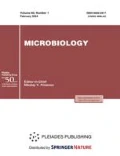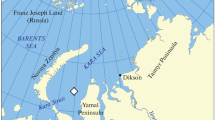Abstract
Functioning of microbial communities in surface sediments of the Haakon Mosby underwater mud volcano (lat. 72°N) and in gas seepage fields of the Vestnesa Ridge was investigated using Mir-1 and Mir-2 deep-sea submersibles during the 40th voyage of the research vessel Academician Mstislav Keldysh. Large areas of sedimentary deposits of the Haakon Mosby mud volcano (HMMV) and pockmarks of the Vestnesa Ridge (VR) are covered with bacterial mats 0.1 to 0.5 cm thick. The microbial community making up bacterial mats of the HMMV was dominated by large filamentous bacteria with filaments measuring up to 100 μm in length and 2 to 8 μm in width. The occurrence of rosettes allowed the observed filamentous bacteria to be referred to the morphologically similar genera Leucothrix or Thiothrix. Three morphological types of filamentous bacteria were identified in bacterial mats covering VR pockmarks. Filaments of type one are morphologically similar with representatives of the genera Thioploca or Desmanthos. Type two filaments had numerous inclusions of sulfur and resembled representatives of the genus Thiothrix. The third morphological type was constituted by single filaments made up of tightly connected disk-like cells and can be assigned to the genus Beggiatoa. The rates of methane oxidation (up to 1570 μl C/(dm3 day)) and sulfate reduction (up to 17 mg S/(dm3day)) measured in the surface sediments of HMMV and VR were close to the maximum rates of these processes observed in heavily polluted regions of the northwestern shelf of the Black Sea. High rates of microbiological processes correlated with the high number of bacteria. The rate of methane production in sediments studied was notably lower and ranged from 0.1 to 3.5 μ CH4/(dm3 day). Large areas of the HMMV caldera were populated by pogonophoras, represented by the two species Sclerolinum sp. and Oligobrachia sp. The mass development of Sclerolinum sp. in the HMMV caldera was by the activity of aerobic methane-oxidizing bacteria localized inside the cells of these animals. Bacterial cells were also found in the trophosome tissue of Oligobrachia sp., but in cells of these bacteria, we did not observe the membrane structures typical of methanotrophs. The localization pattern of pogonophoras on the surface of reduced sediments suggests that the predominant bacteria in Oligobrachia tissues are sulfur-oxidizing endosymbionts.
Similar content being viewed by others
Rights and permissions
About this article
Cite this article
Pimenov, N.V., Savvichev, A.S., Rusanov, I.I. et al. Microbiological Processes of the Carbon and Sulfur Cycles at Cold Methane Seeps of the North Atlantic. Microbiology 69, 709–720 (2000). https://doi.org/10.1023/A:1026666527034
Issue Date:
DOI: https://doi.org/10.1023/A:1026666527034




